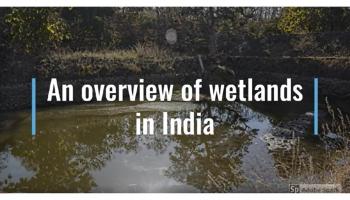/topics/lakes-ponds-and-wetlands
Lakes, Ponds and Wetlands
Using water sustainably in agriculture: Increasing productivity and farm income
Posted on 29 Aug, 2009 01:29 PMAgriculture is a vital sector in India with about 60% of the population engaged in agricultural vocations and contributing to about 30% of the GDP. It consumes about 80% of water used in the country and 76% of the net irrigated area in the country is from ground water sources.
Effect of climate change on the Ganga-Brahmaputra delta regions
Posted on 28 Aug, 2009 02:28 PMThe delta belt is home to approximately 125-140 million people. And over 300 million people are supported by the delta. The density of population in the Delta region is 200 people / sq.km. making it one of the densest regions in the world.
The delta region is a high-rainfall region and receives 60-80 inches of rainfall every year.
Impact of climate change on river deltas and other coastal areas in India
Posted on 26 Aug, 2009 04:23 PMThe effects are most visible in the Sunderbans. Literally the 'beautiful forest', these wetlands at the mouths of the Ganga and Brahmaputra river systems are among the largest mangrove forests in the world. About 62% of this area of some10000sq km lies in Bangladesh but there is a significant Indian portion in the state of West Bengal.
Quick reference: Climate change impacts on freshwater ecosystems in the Himalayas (CCIFEH)
Posted on 26 Aug, 2009 04:01 PMThe programme entails a panorama of actions working towards understanding future climate change impacts on Himalayan river ecosystems and vulnerable communities for the development of adaptation strategies; implementation of pilot sites; and raising the awareness of climate change impacts on Himalayan river basins, in addition to urging specific adaptation strategie
How changing climate and melting glaciers affects nations across the globe: Spotlight on the Himalayas
Posted on 25 Aug, 2009 05:11 PMAs observed by the United Nations Environment Program (GRID-Arendal) ice and snow are major components of the climate system. That is why human induced climate change can be first observed in Polar Regions where most of Earth's snow and ice are concentrated. In these areas global warming induces the progressive melting of ice and snow.
The many impacts of climate change - A serious global environmental issue?
Posted on 25 Aug, 2009 03:14 PMThe earth is currently warming rapidly. And this warming is bringing about massive changes. Our glaciers are melting rapidly. The artic ice-shelf is breaking apart into pieces and threatens to modify the salinity of the oceans.
Films and video resources on climate change and greenhouse gas emissions from the Centre for Science and Environment
Posted on 24 Aug, 2009 10:26 AMA number of films on climate change are available on the Centre for Science and Environment (CSE) store. These include:
Workshop on urban lake monitoring & management by CiSTUP, Bangalore
Posted on 22 Aug, 2009 05:01 AMImage & Content Courtesy: CiSTUP
Indian Institute of Science is conducting a Workshop on URBAN LAKE MONITORING & MANAGEMENT from 23rd to 25th of September 2009 and a Brainstorming Session on Conservation & Management of Urban Lakes on 26th September 2009
Venue: CiSTUP seminar Hall (SID Building), IISc campus (location details are available at http://cistup.iisc.ernet.in)
Workshop schedule: 9:30 AM to 6:30 PM
The workshop is meant for Research Scholars and Master students. The age of the participant be less than 30 as of 30 August 2009 (no registration and accommodation charges for selected young researchers).
Interested applicant should send a write-up (less than 750 words each) on “Need and challenges of wetland Monitoring and Management in India” and “How wetland monitoring workshop would benefit their career” (One page on each title). Application and write-up is to be routed through their institution. Selected outstation candidates will be paid Rs 500/- as their travel support and accommodation and food during the workshop will be taken care by the organizers.
Rainwater harvesting in India: Traditional and contemporary
Posted on 21 Aug, 2009 12:41 PMThe document informs that traditionally Indians worshipped both water and rain as “Jala” and “Varuna”. Even rivers were worshipped. Till 3000 B.C., RWH happened without human effort as rain got collected in rivers and natural depressions. Civilizations flourished on river banks all over the world Indus valley civilization in India.
Technologies for lake restoration: A paper from Helmut Klapper on water quality and restoration of lakes
Posted on 20 Aug, 2009 03:46 PMDownload this guide to technologies which can assist you in your goal to restore lakes.









